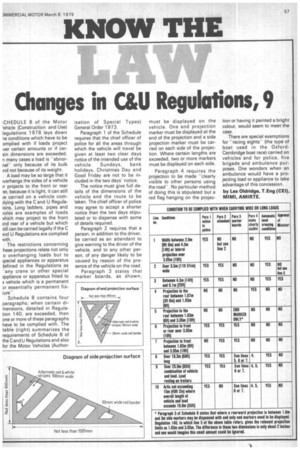Changes in MU Regulations, 9
Page 59

If you've noticed an error in this article please click here to report it so we can fix it.
CHEDULE 8 of the Motor 'ehicle (Construction and Use) legulations 1978 lays down le conditions which have to be omplied with if loads project ver certain amounts or if cer3in dimensions are exceeded.
n many cases a load is "abnornal" only because of its bulk ,nd not because of its weight.
A load may be so large that it iverhangs the sides of a vehicle ir projects to the front or rear ret, because it is light, it can still )e carried on a vehicle cornflying with the C and U Regulaions. Long ladders, pipes and Kites are examples of toads vhich may project to the front ind rear of a vehicle but which till can be carried legally if the C ind U Regulations are complied with.
The restrictions concerning hese projections relate not only
o overhanging loads but to ;pecial appliances or apparatus Jefined in the Regulations as 'any crane or other special 3ppliance or apparatus fitted to 3 vehicle which is a permanent Pr essentially permanent fixture".
Schedule 8 contains four paragraphs; when certain dimensions, detailed in Regulation 140, are exceeded, then one or more of these paragraphs have to be complied with. The table (right) summarizes the requirements of Schedule 8 of the C and U Regulations and also for the Motor Vehicles (Author isation of Special Types) General Order 1973.
Paragraph 1 of the Schedule requires that the chief officer of police for all the areas through which the vehicle will travel be given at least two clear days notice of the intended use of the vehicle. Sundays, bank holidays, Christmas Day and Good Friday are not to be included in the two days' notice.
The notice must give full details of the dimensions of the vehicle and the route to be *taken. The chief officer of police may agree to accept a shorter notice than the two days stipulated or to dispense with some of details required.
Paragraph 2 requires that a person, in addition to the driver, be carried as an attendant to give warning to the driver of the vehicle, and to any other person, of any danger likely to be caused by reason of the presence of the vehicle on the road.
Paragraph 3 states that marker boards, as shown, must be displayed on the vehicle. One end projection marker must be displayed at the end of the projection and a side projection marker must be carried on each side of the projection. Where certain lengths are exceeded, two or more markers must be displayed on each side.
Paragraph 4 requires the projection to be made "clearly visible to other persons using the road No particular method. of doing this is stipulated but a red flag hanging on the projec tion or having it painted a bright colour, would seem to meet the case.
There are special exemptions for "racing eights" (the type of boat used in the OxfordCambridge boat race) carried on vehicles and for police, fire brigade and ambulance purposes. One wonders when an ambulance would have a projecting load or appliance to take advantage of this concession.
by Les Oldridge, T.Eng (CE I), MIMI, AIVIIRTE.












































































































